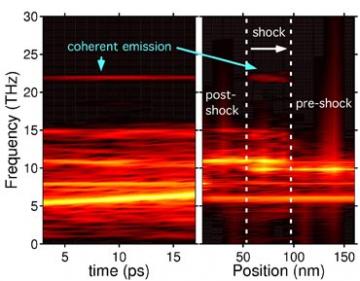| Energy Projects | |
|
..
Livermore researchers find new source
of coherent light. This figure shows the emission of coherent light at
22 THz from a molecular dynamics simulation of shocked NaCl (table salt).
The left panel shows the emission of the light as a function of time while
the shock is propagating. The right panel shows the generated radiation
as a function of location within the shocked crystal indicating the 22
THz coherent signal is generated at the shock front (between the white
dotted lines). With the exception of lasers and free electron lasers, there
hasn't been another fundamental way to produce coherent light for close
to 50 years. However, a group of researchers from Lawrence Livermore National
Laboratory and the Massachusetts Institute of Technology have found a new
source of coherent optical radiation that is distinct from lasers and free
electron lasers.
|
|
| Applications from this research are numerous, but
the most immediate result may be a new diagnostic tool to determine the
properties of shock waves, said Evan Reed, an E.O. Lawrence postdoctoral
fellow at Lawrence Livermore and lead author of a paper that appears in
the Jan. 13 edition of Physical Review Letters.
Through a series of theoretical calculations and experimental simulations, scientists generated a mechanical shock wave inside a dielectric crystalline material, in this case kitchen salt (NaCl). One might expect to see only incoherent photons and sparks from the shocked crystal. But what they found was so much more. Weak yet measurable coherent light was seen emerging from the crystal. The emission frequencies are determined by the shock speed and the lattice make-up of the crystal. The team found that measurable coherent light can be observed emerging from the crystal in the range of 1 to 100 terahertz (THz). "To our knowledge, coherent light never has been seen before from shock waves propagating through crystals because a shocked crystal is not an obvious source to look for coherent radiation," Reed said. "The light and radiation was in a portion of the electromagnetic spectrum that is not usually observed in these types of experiments." Coherent light is very narrow bandwidth radiation; it is useful for interferometry (the measurement of two or more waves coming together at the same time and place, such as optical and shock waves) and is usually associated with lasers. The invention of the laser in 1958 as a source of coherent light enabled a wide range of applications including medical technologies and energy production because of the coherence of the light they generate. However, producing coherent light from a source other than a laser can serve as a diagnostic for understanding shock waves, specifically providing information about shock speed and the degree of crystallinity, Reed said. In the computational experiments, the researchers observed the light generated by a shocked polarized material by performing molecular dynamics simulations of shock waves propagating through crystalline NaCl. The simulations solved the classical equations of motion for atoms that are subject to interaction, thermal effects and deformation of the crystal lattice. The intensive computer simulations were made possible by utilizing LLNL's Thunder parallel computer. |
|
|
|
|
| FAIR USE NOTICE: This page contains copyrighted material the use of which has not been specifically authorized by the copyright owner. Pegasus Research Consortium distributes this material without profit to those who have expressed a prior interest in receiving the included information for research and educational purposes. We believe this constitutes a fair use of any such copyrighted material as provided for in 17 U.S.C § 107. If you wish to use copyrighted material from this site for purposes of your own that go beyond fair use, you must obtain permission from the copyright owner. | |
| ~ MENU ~ |

